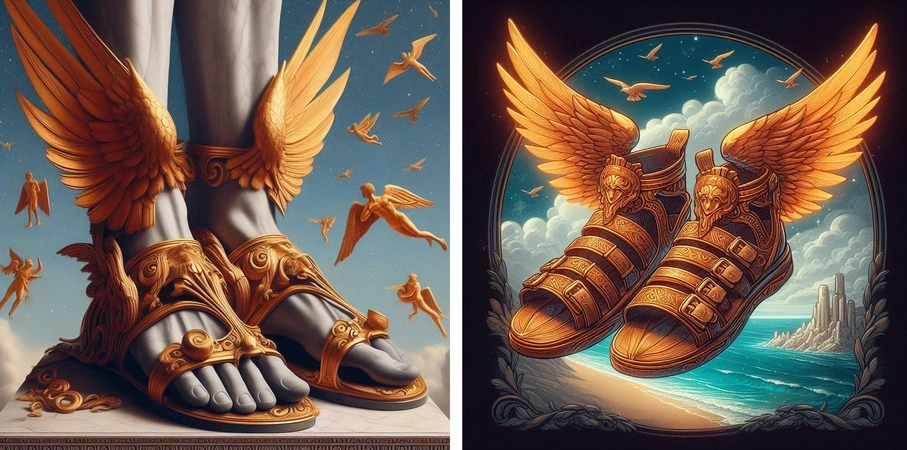
In Greek mythology, Hermes is known as the god of commerce, thieves, travelers, and the messenger of the gods. He is often depicted with wings on his feet, symbolizing his ability to move quickly and easily between different places. This unique attribute of Hermes has made him a popular figure in art, literature, and culture, both in ancient Greece and today.
Hermes is the son of Zeus, the king of the gods, and the nymph Maia. He showed great intelligence, wit, and agility. In fact, according to the myth, he was able to steal some of his brother Apollo‘s cattle soon after he was born, and he cleverly covered up his tracks by walking backwards.
As he grew up, Hermes became known for his mischievous and cunning nature. He was also a skilled musician and a talented athlete, and he was often seen playing his lyre or running races with other gods and mortals. However, it was his role as the messenger of the gods that truly set him apart.
The most famous representation of Hermes, however, is the one that shows him with wings on his feet. These wings are often depicted as small, feathered wings that are attached to his ankles, allowing him to fly or run at incredible speeds. This attribute has made him a popular figure in art and culture, and he has been depicted in many different ways, from elegant and graceful to playful and mischievous.

The wings on Hermes’ feet also represent his ability to move between different worlds and realms. In Greek mythology, the gods and mortals lived in separate worlds, and it was rare for them to interact with each other. However, Hermes was able to move freely between the two worlds, acting as a bridge between them. He was also able to travel to the underworld, where he acted as a guide for souls who were crossing over into the afterlife.
Hermes’ speed wasn’t just for show. As the messenger god, he was tasked with carrying messages and decrees from Zeus to the other deities. He also served as a guide for lost travelers, particularly those venturing into the underworld. His winged sandals ensured he could fulfill these duties with unmatched swiftness.
The winged sandals weren’t Hermes’ only magical tools. He wielded the caduceus, a staff entwined with serpents, which symbolized his role as a mediator and negotiator. He also carried a magical purse called a kerykeion, which could be used to lull people to sleep or awaken them. These tools, combined with his winged sandals and inherent abilities, made him a truly versatile god.
The Origin of His Winged Sandals
The story of how Hermes acquired his iconic winged sandals is a fascinating tale that reflects his cunning and resourcefulness. According to myth, shortly after his birth, Hermes displayed remarkable agility and curiosity. One day, while exploring the slopes of Mount Olympus, he encountered a tortoise and was struck by its sleek and nimble movements.
Inspired by the tortoise’s agility, Hermes crafted the first lyre using the shell of the tortoise and sinews from a sacrificial animal. He then presented his creation to Apollo, the god of music, who was so impressed by Hermes’ ingenuity that he offered him his own golden staff in exchange.

However, Hermes was not content with just the golden staff. Determined to further enhance his abilities, he sought the assistance of Hephaestus, the god of craftsmanship, renowned for his skill in forging divine artifacts. With Hephaestus’ guidance, Hermes fashioned a pair of winged sandals, imbued with magical properties that granted him the power of flight and unmatched speed.
Facts about Hermes’ Winged Sandals
Hermes, the swift-footed messenger god, is instantly recognizable by his iconic winged sandals that grant him incredible speed. But beyond their visual appeal, these magical footwear hold fascinating stories and unique properties:
- Not Just Wings: While the most prominent feature is the wings, depictions of the sandals vary. Some describe them as simple sandals with wings attached, while others portray them as intricate boots that incorporate the wings seamlessly into their design.
- Multipurpose Magic: The sandals’ power extended beyond just granting speed. They were said to allow Hermes to fly, walk on air or water, and even travel between realms with incredible ease. This versatility made them an essential tool for his diverse duties.
- The Sound of Speed: Some myths claim the sandals produced a distinctive whispering sound as Hermes moved at high speeds. This sound served as a warning or announcement of the god’s arrival, adding an ethereal touch to his swiftness.
- Beyond Hermes: While most associated with Hermes, the winged sandals weren’t exclusive to him. In some stories, other deities, like Iris, the messenger goddess, or even mortals like Perseus, were gifted or acquired winged sandals, highlighting their symbolic nature beyond a single god.
- A Legacy of Speed: The influence of the winged sandals extends beyond Greek mythology. The Roman god Mercury, Hermes’ equivalent, also donned similar footwear, solidifying the image of the swift messenger across cultures.
| The winged sandals became an integral part of Hermes’ identity, symbolizing his role as the messenger of the gods and the patron of travelers. With these miraculous sandals adorning his feet, Hermes traversed the heavens and the earth with grace and agility, bridging the gap between mortals and immortals. |